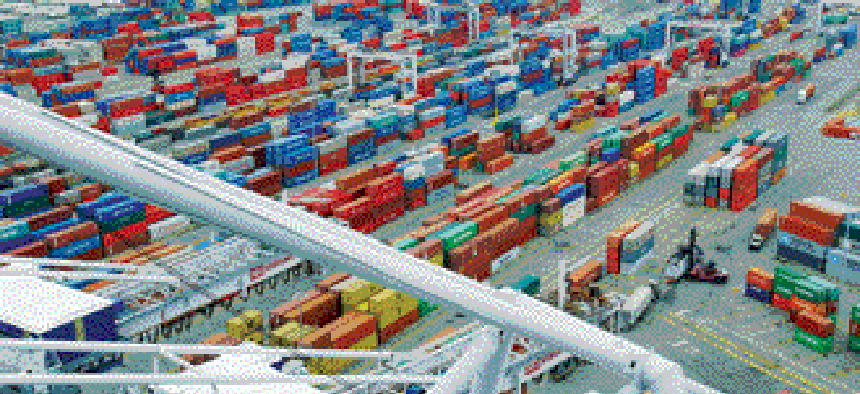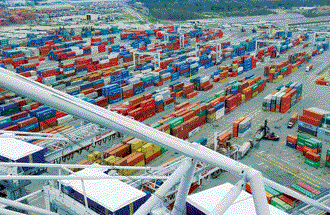Souped-up grant programs target port security

As Congress prepares to approve increased funding for port security grants, contractors said the money is likely to pay for more comprehensive surveillance, domain awareness and information-sharing IT systems which, in many cases, systems integrators are installing.
Security doesn't stop at the water's surface at the Port of Lake Charles in Louisiana, one of largest liquid natural gas ports in the country. Underwater sonar, radar and a network of sensors search for threats.The information is charted into a common operational picture that is shared with nearby agencies, including law enforcement, Coast Guard and immigration officials.As Congress prepares to approve increased funding for port security grants, contractors said the money is likely to pay for more comprehensive surveillance, domain awareness and information-sharing IT systems which, in many cases, systems integrators are installing.The Homeland Security Department listed protection against improvised explosive devices as a top goal of its port security grants for 2005, and is expected to do so again for 2006 grant guidance. To guard against such dangers, many ports implement surveillance and intrusion detection systems that are shared with law enforcement."It's not gates, guns and guards any more," said Aaron Ellis, a spokesman for the American Association of Port Authorities, a trade group for 85 major ports. "Ports are moving to more sophisticated and technically advanced equipment."The post-Sept. 11 goals of port security initially were to fence perimeters and install gates, Ellis and others said. Recently, focus has been on IT surveillance and communications networks that can offer a common reference point and tools for use among response agencies.Major port security contracts are attracting major systems integrators, including L-3 Communications Corp., Lockheed Martin Corp. and Science Applications International Corp. For example, SAIC won a contract for an integrated surveillance system in the Port of Miami. The value was not disclosed.Several smaller integrators have won port security contracts, including Zel Technologies LLC for networked systems at the Port of Norfolk, Va., and Ciber Inc. for the harbor security system at the Port of Lake Charles."We competed with all the major defense companies" for the Norfolk port, said Joe Bouchard, senior program executive for homeland security and maritime security with Zel Technologies of Hampton, Va. "All the major systems integrators compete fiercely for these big port contracts," he said.Both Norfolk and Lake Charles are examples of the trends in IT work at ports.At the Lake Charles port, systems integrator Ciber of Greenwood Village, Colo. installed a harbor management and security system that began operating May 4. In it, several surveillance systems are integrated into a single, wireless network, and then linked with vessel and crew information databases to create a common operating picture. That picture is available not only to port officials, but to police, fire, Coast Guard, immigration and more than two dozen other first-response authorities nearby, said Bill Parker, maritime practice director for Ciber's federal solutions division.The information can be geographically customized to each agency's jurisdiction and mission. For example, a local firehouse may not want all port alerts, just those on detections within its area, Parker said."We've created virtual protection zones," Parker said. "And we extend the information outward over a virtual Web."In Norfolk, a $6 million federal port security grant is paying for a new regional microwave network that links 16 cities and counties with command centers, Coast Guard and Virginia port authorities, among other agencies.It will establish voice and radio interoperability, provide voice over Internet Protocol telephone capabilities and create a common operational picture for distribution to the communities, Zel's Bouchard said."Maritime domain awareness is not just cameras and radars. The emphasis is actually on information-sharing and being able to share data in real time," Bouchard said."It is a network-centric approach," he said. "Everyone already has a command center. You need to link them together on a network to create a common operational picture."The microwave network will link with Virginia Port Authority surveillance cameras and the Navy and Coast Guard's joint harbor operations center operating at the Naval Station Norfolk. Bouchard, a former Navy captain, was instrumental in helping to create the operations center in 2002.Many more ports are creating communications networks, surveillance systems and operations centers. Many have installed cameras and access control systems, but they have become more sophisticated about surveillance and intrusion detection in recent months, Ciber's Parker said.Even so, several ports have significant blind spots, he said, and the midsize and larger ports are installing comprehensive systems over wireless networks that extend throughout a region."There is more money coming for integrated regional systems, with shared access for different entities and stakeholders," Parker said.Port security received a huge boost in attention because of the controversy surrounding Dubai Port World's attempt to acquire a company that managed several U.S. ports. The deal was scuttled after Congress objected to foreign ownership for such national-security-related work, though the award had been vetted by the administration.The media attention has led to proposals to increase port security grants to guard against maritime terrorism. The House in April authorized $2.4 billion in such grants to high-risk ports over the next six years, including $400 million in fiscal 2007, but the House Homeland Security Appropriations Subcommittee has approved $200 million in such grants for next year.The grant money can pay for purchasing and upgrading security equipment such as video surveillance systems, waterside surveillance vessels, vehicle inspection stations, closed-circuit television and access-control equipment for the main gate.In addition, the Senate voted in favor of an emergency appropriations bill that immediately adds $227 million to the port security grants, up from the $175 million appropriated for fiscal 2006. However, President Bush has threatened to veto the massive emergency bill, which was initially intended to help fund primarily the war in Iraq.The funding outlook for port security grants has brightened. "We're cautiously optimistic," Ellis said. "The Dubai incident has raised the level of awareness about maritime security."Ports have been receiving security grants for three years under the Maritime Transportation Security Act of 2002, which, to date, has distributed $708 million to ports, Ellis said. However, the Coast Guard has estimated that ports' cost of protecting facilities in compliance with the act would cost $5.4 billion over 10 years."Ports are spending millions of dollars of their own money to comply with the act," Ellis said. Many ports have installed surveillance systems, but they are frequently limited in scope.In addition to cameras and sensors, ports are buying video analytics to make sense of the surveillance data that is being generated."We're generating so much data. The next level is software processing, so the data can be made manageable," said Glenn McGonnigle, chief executive of VistaScape Security Systems Corp. of Atlanta, makers of video analytics for surveillance systems.

Shift in focus
Opportunities aplenty
Staff Writer Alice Lipowicz can be reached at alipowicz@postnewsweektech.com.

Increased funding for port security likely will go toward comprehensive surveillance, domain awareness and information-sharing IT systems, contractors said.
Rick Steele
Shift in focus
Opportunities aplenty
NEXT STORY: Deltek charts int'l course

